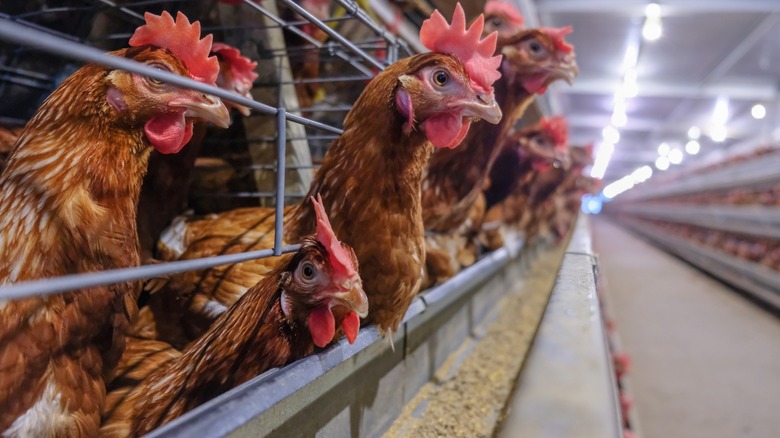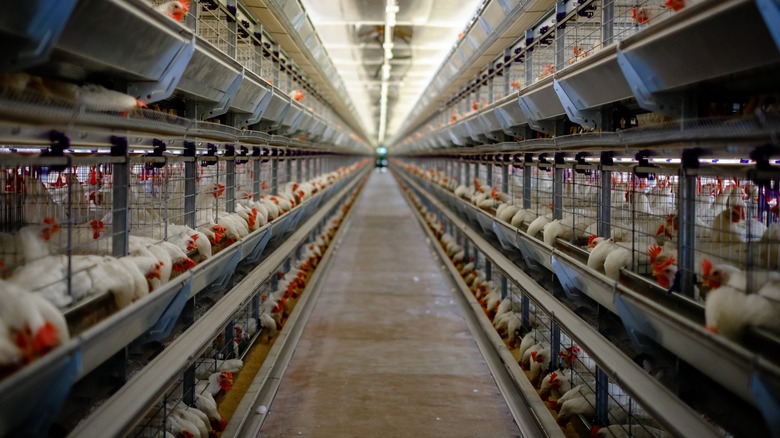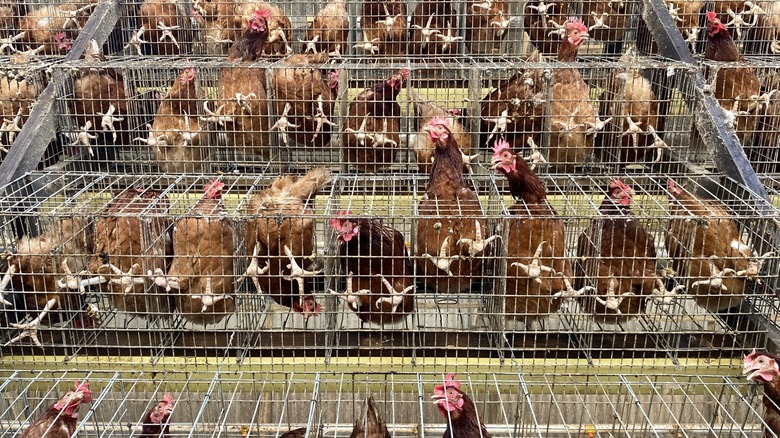What It Means When Eggs Are 'Battery Farmed'
The conditions of farms where hens are raised and lay eggs are a growing concern around the globe over the past two decades. Considering the sheer multitude of people who consume eggs, it shows no signs of slowing down, either. This shift towards more conscientious shopping has led to a bevy of "free-range," "cage-free," and "barn-laid" labels on supermarket cartons, but battery-farmed eggs still remain the most common form of production. This technique involves placing hens in tightly packed cages so that they lay eggs like a factory conveyor belt system.
Battery caging, named for the way the cages are stacked on top of each other and lined up in rows to create one unit, is a highly controversial practice. The hens inside have little to no room to maneuver, and they often experience physical and behavioral distress as a result of their inability to freely feed, roam, and nest in accordance with their instincts. The inability to spread wings or properly build a nest can make hens aggressive. Practices to reduce this behavior, namely beak-clipping and specified light levels, cause further pain and stress, as does the wire mesh floor of the hens' stand. This is also on top of the egg-laying strain.
Legislation on battery farming
Battery farming became common practice in the 1950s, when mass agriculture replaced small farming practices. New technology and a booming economy made it both easier and more profitable for corporate farms to mass produce grain and livestock. As a resullt, battery caging became the predominant form of egg production, and as of 2014, hens in battery cages still made up about 95% of the total egg-laying population.
Since the turn of the millennium, however, there has been a shift towards more humane egg production and raising of hens. The European Union voted to ban battery cages in 1999 (although the law didn't go into effect until 2012), and in 2008, Californian voters chose to ban eggs sold from battery-caged hens. Washington, Oregon, Michigan, Massachusetts, Rhode Island, Utah, Colorado, and Ohio have followed suit with bans on battery cage production. Most notably, Ohio, which has the largest population of egg-laying hens, issued a moratorium on new battery cage operations in 2010. In addition, Canada is currently in the process of phasing out battery cage facilities with Australia following behind in a promise to stop selling battery-farmed eggs by 2036.
The future of battery farming and egg production
Battery caging may be more taboo than it was in the twentieth century, but the farming technique still remains the most common method of egg production both nationally and globally. More than 75% of egg-laying hens are in states with no battery farming legislation, and about 13% of egg production will occur in states with these types of laws by 2026 if other states don't adopt these measures. On the other hand, less than 70% of hens are battery-caged in 2023, a significant drop from 95% in 2014. In addition, 38.3% of egg-laying hens in America are cage-free as of March 2023.
Bans on battery cages don't necessarily denote an end to controversial egg production, either. "Cage-free" is a broad and misleading term since hens can still be raised in cramped barn sheds with low-quality care, but the means of egg production varies from farm to farm. Free-range hens may be more humane, but large flocks of undersupervised chickens can make it more difficult to control aggressive behavior and sanitation, leading to potential outbreaks of cannibalism and bird flu. Free-range eggs are also more costly to the average consumer. Still, any of these methods provide hens with a happier and more natural lifestyle than when they're in battery cages.



